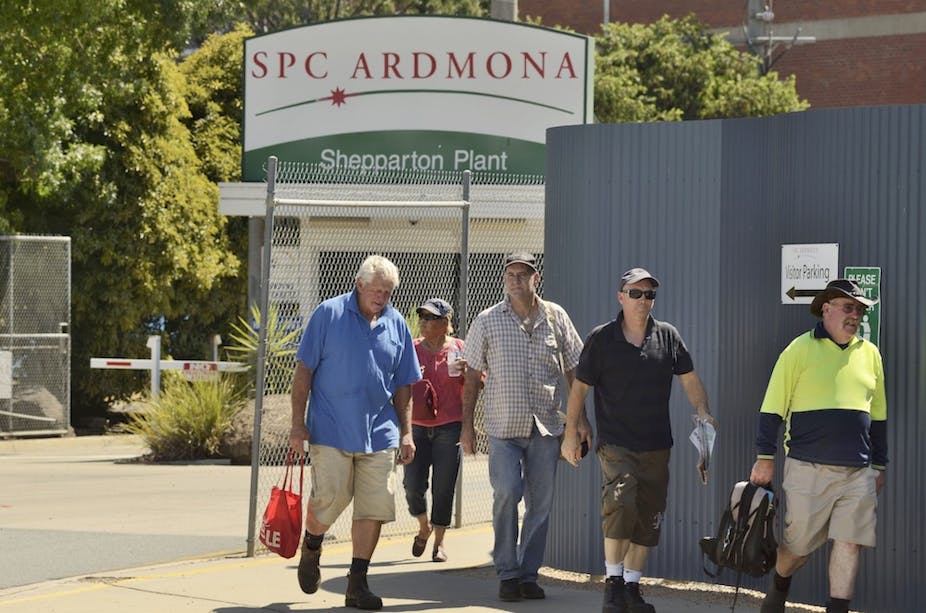The failure of Victorian fruit cannery SPC Ardmona (SPCA) to secure A$25 million from the federal government has led to heightened fears about the future of the company and the Goulburn Valley fruit growers who supply it.
The response from SPCA’s parent company, Coca-Cola Amatil (CCA) to last Thursday’s decision is that it “will necessitate a material review of SPCA’s carrying value, and a write down of its assets including brands and goodwill”.
For the growers, this illustrates the risks of depending on markets controlled by large and remote corporate interests that are exposed to global competition. The federal government’s position, applied consistently in this case, is that if your product can’t compete then you need to do something else – your problem.
So what if SPCA does close? The major market channels for fresh fruit are fully supplied and demand is static. Export, the traditional solution for Australian farmers facing this situation, is certainly possible, but competition is stiff.
Or orchard land could be used for something else. The dairy industry is keen for more product, but that would represent a loss of economic and skills diversity in the region. Besides, not every fruit grower wants to milk cows, nor are their farm sizes or infrastructure suitable, so there would be social dislocation with this option too.
Innovating the food system
If we have passionate growers who want to keep growing, and passionate eaters interested in more than the price of food, can they be connected in new ways?
The Goulburn Valley Food Co-op (GVFC) has been exploring this idea for the last two years. It arose from the closure of the Heinz tomato factory in Girgarre in 2011 and despite several setbacks it brought two products successfully to market in 2013: a pasta and tomato sauce meal, and a pear cider.
GVFC has pioneered the concept of “virtual factories”. Rather than developing their own processing facilities they have contracted with existing underutilised factories to produce products that are branded by their producers, but then marketed via GVFC networks, and with its imprimatur. The regional provenance and community values that GVFC represents are something that some consumers value and are prepared to pay for.
Scaling up
GVFC is part of a much wider set of experiments in “alternative food networks” that aim to provide new options for growers and consumers. Farmers’ markets and food hubs are other examples. The standard criticism is that they constitute tiny and finite “niches” in the market. This is a valid and important point. SPCA is expecting to process 150,000 tonnes of produce in 2014, whereas GVFC has so far managed to process and sell less than 100 tonnes.
GVFC’s public officer Les Cameron recognises the challenge, but doesn’t believe it is insurmountable:
“We’ve shown that a market does exist for credible and superior quality regionally-branded products. I don’t think we should pre-judge what the ultimate size of that market could become. If we move to distribute the cider nationally we’d scale up into the thousands of tonnes pretty quickly.”
Back to the future?
A GVFC media release this week states that “If Australia is to have a viable food processing industry, we need SPCA”. But Les is clear that their business model needs to change:
“They’ve continued basically with a ‘grower-forward’ model. The fruit arrives, you put it in cans, and wait for someone to buy it. What is needed now is a customer-driven model where you can move nimbly to make new products that people want. We got our cider from concept to bottle in six weeks.”
The investment in retooling and innovation that the federal government funding was to support is needed to reconfigure the factory for this change. But perhaps the money can come from elsewhere. Les Cameron again:
“The good news is that raising $25 million is a straightforward task. When negotiating with Heinz we were offered well over $18 million from various investors provided we were taking the Girgarre tomato plant over as a going concern. SPCA is a light year ahead of where Heinz was at that stage.”
GVFC is interested in exploring possibilities for “a new form of private public partnership” with SPCA and CCA, that might see the Goulburn Valley community own a stake in the factory again, as in its earliest days. GVFC says a number of conditions would need to be in place for such a venture to succeed, including community representation on the board, and an on-going commitment to innovative and short-run products.
Cameron says action is needed from the federal government too:
“The Abbott government has said they will be "getting the regulatory settings right so that industry can succeed”. The first effort must be to change the “country of origin” labelling laws so that food labelled “Made in Australia” means what ordinary consumers think it should mean – food that is grown here and processed here.“
CCA and SPCA haven’t yet responded to the community buy-in idea, and why should they? What’s in it for them? That depends how much value they see in the ethical and socially-embedded innovation, branding and marketing reach that GVFC has demonstrated.

